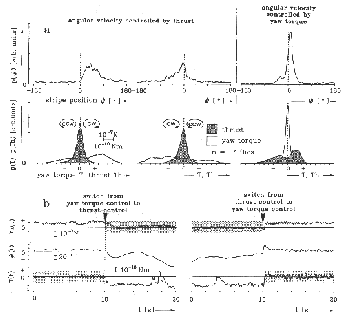Thrust Can Operate Flight Direction
In this paradigm, the fly can use either its yaw torque (as in the Drosophila flight simulator) or its thrust to control the horizontal angular motion of a vertical dark stripe in its visual field. In open loop, the fly modulates its thrust in response to the movements of the stripe: front-to-back motion causes a decrease, back-to-front motion an increase of thrust. A closed loop couples larger-than-average thrust to clockwise and lower than average to counter-clockwise rotation of the arena with the stripe. The fly immediately adjusts its thrust to a level that corresponds to zero net rotation of the stripe. The fly stabilizes the stripe on its right where the translatory motion component of the stripe is negatively coupled to thrust, i.e. below average thrust causes back-to-front motion and larger than average thrust the opposite. If the coupling between thrust and rotational direction is inverted, the stripe is stabilized to the left of the fly. Simultaneously recording yaw torque shows only occasionally parallel or antiparallel modulation; most of the time there is no correlation between the motion of the stripe and yaw torque. If the fly is allowed to use yaw torque to control the panorama, thrust is 'floating' freely. After a switch from thrust to yaw torque control the fly needs approximately 200ms to stabilize the stripe. It takes the fly up to several seconds after the vice versa switch, suggesting that the system more frequently (or more efficiently) activates yaw torque than thrust.
Angular velocity and position of a target is alternatively controlled by yaw torque and thrust. Yaw torque (T), thrust (Th) and stripe position (Psi), i.e. the angle between the fly's longitudinal body axis and a vertical dark stripe (width d = 5°, height delta = +-40°) are recorded simultaneously in the flight simulator under 3 different feedback conditions. Normal flight simulator conditions are an inverse proportionality between angular velocity of the panorama (simulating self-rotation of the fly) and yaw torque as shown in (a) on the right. In order to stabilize the panorama the fly must keep yaw torque around T = '0' [Nm]. The stripe preferentially is kept in the frontal part of the visual field (upper histogram on right). In this situation thrust is modulated over a wide range. Feedback control of angular velocity by thrust, on the other hand, requires that an arbitrary thrust level is associated with zero angular velocity. With this reference value positive (Th > '0') and negative (Th < '0') thrust can be defined. The two shaded histograms of thrust in the left and middle columns of (a) show that during feedback with thrust the latter is kept around zero whereas now yaw torque floats freely. Feedback conditions differ in the experiments shown in the left and middle columns. On the left increasing positive thrust leads to increasing clockwise rotation of the stripe, increasing negative thrust to increasing counterclockwise rotation. In the middle column this relation is inverted (Th>'0'=>ccw; Th<'0'=>cw). For each of the two coupling modes the stripe is stabilized only on one side. This is due to the fact that front-to-back motion decreases and back-to front motion increases thrust in open loop. Therefore, negative feedback (i.e. stabilization of the target) is given only on that side where Th>'0' leads to front-to-back motion. In (b) individual traces of yaw torque, thrust and stripe position are shown for switches (arrowheads) from yaw torque to thrust control and vice versa (shaded areas= periods of feedback control). Note that after being coupled to the target thrust may take several seconds to adjust to the 'zero' level whereas yaw torque takes only a fraction of a second.
